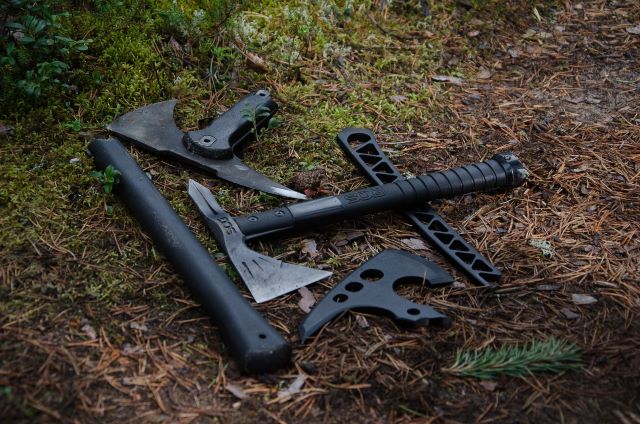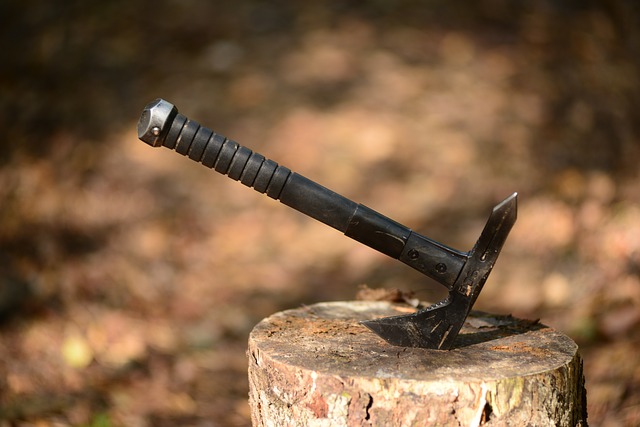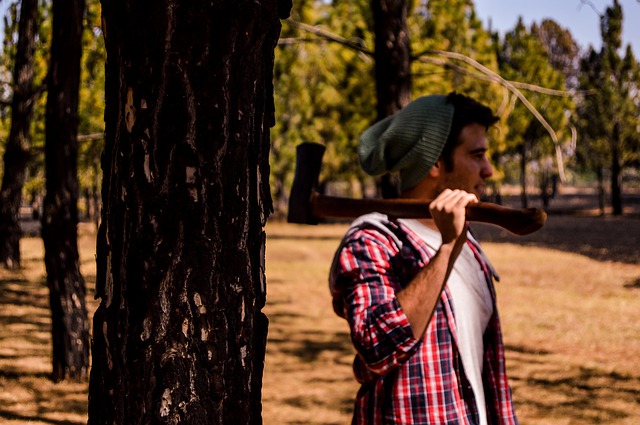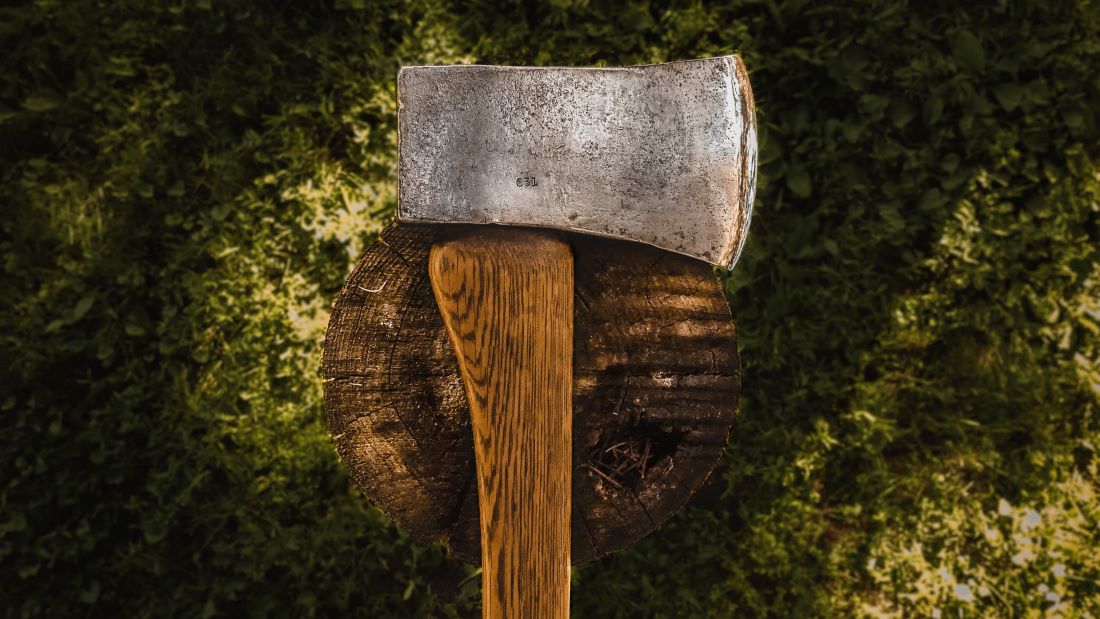Whether going backpacking for a day or camping over the weekend, every trip in the wilderness requires proper tools. From the right shoes to the right axes or hatchets, you need to come prepared with suitable gear. For that, we have comprised a guide on buying the best backpacking axe or hatchet.
Firstly, axes and hatchets are tools every backpacker needs to carry. They come handy when wood and branches are needed to start a fire as well as a defense and in various other situations. That being said, it is easy to mistake one for another since they have a similar design. Namely, axes are larger of both tools and require both hands to be used while chopping. Hatchets are also known as one-hand axe because they can be used one-handedly because of the smaller size. On many occasions in the wilderness situation might arise when you need an axe or a hatchet due to their vast usage. Whether you need to hunt for food, set up a tent or an emergency shelter, chop some wood for fire or defend yourself, this tool will become your best friend.

Now that you understand why you need an axe or a hatchet and you know the difference between the two, you might think it’s easy to pick one, since they all look quite similar, right? Well, you’d be wrong. You see, although the design is the same, all hatchets and axes use a different set of material making them vary in weight and ergonomics. Those two factors alone can determine your success of using the tool, so with that in mind, we have created this extensive buying guide that will guide you through each advantage and disadvantages as well as every other aspect of picking the right tool.
Picking the perfect axe or hatchet
Choosing the best axe for backpacking or a hatchet depends largely on the type of trip you’re taking. For instance, when it comes to a day-long backpacking trip where you know you’ll be back by the evening, a hatchet comes in handy because of its lighter weight. It will still chop whatever you need, but you will be able to save some space for the rest of the gear and tools. On the other hand, multi-day camping requires an axe, since it won’t only chop wood but will be helpful in every other situation you find yourself in because of its size, weight, and strength.
That being said, each hatchet and axe have certain characteristics that make them different from one another. Use the following list as a guide on what you should be looking for in a tool of this kind.
Type of tool
Hatches and axes come in 3 different types depending on their design and usage. There’s a survival axe or a hatchet, a tactical, and camping type.
When it comes to survival axe or a hatchet, those are larger-scale tools for outdoor adventurers that want to get the most out of their trip. With a survival axe or a hatchet, you can chop larger pieces of wood, build shelters, break locks, and other heavy-duty activities.
The tactical axes and hatches differ by being thinner hence slightly lighter in weight and ideal for backpacking and shorter trips. These tools can be used for defense as well as chopping branches rather than larger pieces of wood.
Lastly, the camping axes and hatchets are mid-sized tools and pretty easy to handle whether a beginner or a seasoned camper. You can use them for activities like hammering in tent poles to splitting wood without any issue.

Steel
When it comes to the quality of hatches or axes, the type of steel largely determines how durable your tool will be. Namely, steel is a mixture of iron and carbon. With that, there are two types. Plain carbon steel that has no other elements added to it and alloy steel with Manganese, Nickel, Sulfur or Chromium added in the mixture. Now, in order to know what you can expect, the following are properties of the tool you should look for when buying.
- Initial sharpness: How sharp the axe/hatchet is initially produced which determines whether you have to sharpen it further or not before the first use
- Edge retention: This indicates how does the blade maintains its sharpness without sharpening it over and over again
- Toughness: How much shock the steel can absorb. The higher the better
- Hardness: The capacity of the steel to withstand deformation and hard usage. You will see numbers going from RC54 to RC62. This is the Rockwell Scale and the higher the number is the harder the material is, while the lower number correlates with softer steel
- Deterioration resistance: This is also shown on the Rockwell Scale with the same numbers that indicate its ability to withstand corrosion
- Ductility: This indicates how flexible the steel is
Handle
When picking the best axe for backpacking or camping, the handle material largely determines how well it serves you. We’ve talked about the types of steel and how to get a solid one, but the handle shouldn’t be forgotten. Namely, the three most common handle materials are wood, fiberglass, and leather.
Wood is the first material axes and hatchets used for production and despite the innovations and changes, to date, it stayed the most reliable handle material. It absorbs shock and withstands temperature changes well.
Fiberglass is also a pretty common handle material when it comes to hatchets and axes, it’s practical and absorbs shock well. One downside is that some folks don’t find it as comfortable to handle.
The leather, on the other hand, is very comfortable and gives you a good grip. When properly sanded and well-taken care of, it offers long-lasting usage.

Size
The size of the axe or the hatchet does not only indicates the weight but also how easy and precise it is. While the handles don’t add up in weight and are pretty much the same in length, head size is what you should pay attention to. A hatchet head of about 10-12 inches or 12-14 for an axe is pretty easy to use yet functional.
Weight
We already mentioned weight as a factor to be considered since you’re backpacking. While every hatchet and axe are different, when buying, try out several of them to see how they feel. Just remember that opting for the heavier doesn’t always mean highest quality because technique and experience are what matters. So, pick something lighter in weight that won’t weigh you down or tire you while swinging.
Balance
Last but not least, balance. The size and weight play a big role in using your hatchet or axe but the balance is something that will make all the difference at the end. Namely, your ideal axe handle should be the same weight as the head. To determine this take the axe where the head meets the handle and balance it on one finger. If it leans towards the head, indicating that the handle is slightly lighter, then you have a good tool.

How to carry your axe or hatchet
Now that we have determined the culprits of the best axe for backpacking, it is time we talk about transport. The best way to carry an axe when backpacking is by keeping it safe in a sheath. When buying your axe or hatchet, they should come with one, but you can also buy it separately. The sheath won’t only protect the blade of the tool but it’ll also protect the things around it from tearing. This is the safest way to handle this type of tool making it the best way to carry an axe when backpacking.
Other accessories and proper maintenance
After choosing your best backpacking axe or
hatchet you should take other accessories into account. Namely, apart from the
sheath that will provide safety when carrying, you should get a solid sharpening stone to keep the
blade sharp. Eye-protection glasses are also recommended when chopping wood because the chips that fly out might
hurt you.
As for the maintenance, you need:
- Wood oil
- Gun oil
- Bee’s wax
- Paper towel
- Fine grit sandpaper
- Leather better
Maintaining the wood handle of the axe is recommended once a year, but if you live in a more wet area or you keep your axe in such, then oiling should be done more frequently. Leather handles should be oiled and left to absorb the oil for a few hours in the sun, while the wooden handles require a bit more care. Below are 6 simple steps to maintaining each part of your axe or hatchet properly.
- Prepare the wooden handle by cleaning it with a damp cloth. Use the fine-grit sandpaper to remove any dirt.
- Wrap the handle in a paper towel and pour the oil on it until the paper is soaked in oil. Make sure you put oil on the bottom of the handle and the top where it is surrounded by the steel.
- Leave the wrapped handle for 2 hours in the sun or in any warm area because the wood absorbs more oil in warmth.
- After wiping the excess oil off the handle, apply bee’s wax to improve the grip.
- Spray gun oil to the blade generously and leave it head down to dry off for 2 hours. Do not wipe the excess but simply leave it on until next use.
- The sheath should be wiped with Leather better paste. Apply the paste as long as the leather absorbs it.
Now your axes and hatchets are ready for new adventures.
Our Choices
We’ll start with a classic: Estwing Sportsman’s Axe. It is forged in one piece, and made to last, being the perfect tool for all the wood-related activities, from splitting firewood to shopping down small trees. The leather grip offers a durable and confortable finnish, paired with the heavy duty sheath, included, which provides the optimal protection from that sharp sharp edge.
Now for a little bit of fun, we present you the SOG Tomahawk Pack of 3. These little hatchets, or tomahawks, as they are called, are made for throwing: very light, well balanced, and rather small. They won’t be able to cut any thick branches, but they come with a very sharp blade, excellent for taking with you when hiking or backpacking. They are very low maintenance, just need to be cleaned after use, and SOG will make repairs and replace demaged parts for life, if used and maintained correctly. The come in a 3-unit set, so triple the fun! and with a triple pocket sheath. Also have removable paracord handles. Now all you need is to watch some tutorials on how to throw, and you are all set!
The LIANTRAL Camping Survival Axe is a multipurpouse tool, which includes a compass, a flashlight, a pointed hammer head, a flint with whistle and a knife with saw blade, all bluit-in in the detachable handle. Its axe head that doubles as a hammer is made of stainless steel, and the handle has adjustable length, to better suit your needs.
If you want something really compact, we suggest the Gerber Bear Grylls Survival Hatchet. This is a survival hatchet, made of stainless steel, with non-slip ergonomic rubber grip. Also comes with a sheath and is Bear Grylls approved, which is nice! Because of its size, it is really lightweight as well, and perfect for your backpacking and hiking trips.
And finally not a blade, but something to keep your blade sharp: the Smith’s 50582 Axe and Machete Sharpener. I’s easy to use, and will sharpen any dull axe, hatchet or machete. Its design allows you tu use it with gloves and has a large safety guard. Comes with a cleaning brush. So now you have everything you need to go ahead and use your brand new axe or hatchet for a long time!
Final word
Even if you’ve never done it before, choosing the best backpacking axe or hatchet is not all that hard if you follow the guidelines above. Pay attention to size, weight and how the tool feels in your hands, but most of all, remember that safety while using and proper maintenance are the most important things. Take good care of your tools and they will do all the work for you.








